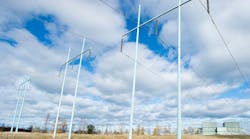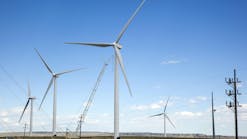NextEra Energy Inc.’s competitive transmission business will invest nearly $2 billion over the next four years in three regional transmission organization projects, a push that executives say embodies the “growing imperative” for new wires to go with renewable-energy assets.
NextEra Energy Transmission, which is home to more than 200 people, last year won contracts to build transmission capacity in the Mid-Atlantic region from PJM Interconnection, in New Mexico from the Southwest Power Pool and in California from the California Independent System Operator. The Florida-based company will put to work a combined $1.9 billion in capital on those jobs between now and the end of 2027, President and CEO John Ketchum said last after NextEra reported its fourth-quarter earnings.
For context, that’s about $500 million more than NextEra Energy Transmission’s transmission capex, two excluding acquisitions, from 2019 through 2022. The division has built a portfolio of competitive transmission assets in California, the Northeast, Texas, parts of the Great Plains and Canada. In all, the venture has invested about $5 billion and last year contributed $411 million in adjusted EBITDA to its parent. That figure was helped by a positive accounting adjustment related to a past acquisition and substantially outpaced the $275 million to $350 million Ketchum and his team had expected in late 2022.
For this year, executives expect NextEra Energy Transmission to produce between $300 million and $375 million in adjusted EBITDA. The midpoint of that range would have the business account for about 4% of the adjusted EBITDA of all of NextEra Energy Resources, the renewables group of NextEra that is on pace to control a 63-gigawatt portfolio by the end of 2026.
“The momentum is terrific,” Rebecca Kujawa, president and CEO of NextEra Energy Resources, said on the Jan. 25 conference call. “And as we’ve highlighted, everybody understands—maybe not to the extent that we think it’s going to happen—[that], in order to unlock the renewables opportunity that we and others see across the United States, transmission needs to be built. And we stand ready to be a part of the solution wherever we can be.”
The ”wherever” in that sentence looks likely to cover a lot more ground in coming years: A 2019 report from consulting firm The Brattle Group estimated that the economy’s electrification from 2031 to 2050 will require at least $7 billion of incremental transmission investment annually on top of the roughly $14 billion that was invested each year from 2006 to 2016. Should electrification trends outpace baseline estimates, the Brattle team said, incremental needs could balloon to $25 billion annually—the majority of it to serve new renewables capacity.
Investments by incumbent utilities will account for a large part of that spending but competitive transmission ventures will get their share, too. Some incumbents, however, have argued that regulators’ efforts in the early 2010s to open up transmission investments haven’t produced the expected results.
In a 2022 report prepared on behalf of a consortium that includes Eversource Energy, Exelon Corp. and Xcel Energy Inc., Concentric Energy Advisors said the 25 competitive transmission projects carried out in the decade prior—six of which were won by NextEra—didn’t bring many new players to the bidding table. On top of that, Concentric’s report said, a sample of competitively sourced projects “have not delivered innovation, cost savings, or timely development of transmission.”
Among those taking the side of more competition is the Electricity Transmission Competition Coalition. The group last summer lauded the Southwest Power Pool’s choice of NextEra, which projected that its work will save New Mexico customers $84 million. This debate isn’t close to settled.


